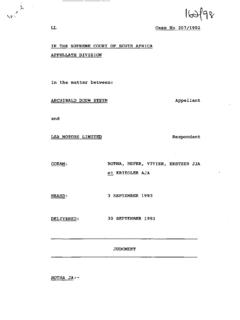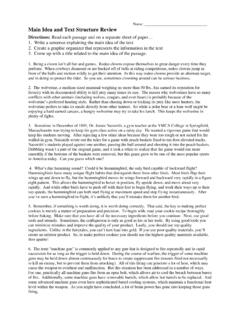Transcription of Technology Innovation Ecosystem Benchmarking Study: …
1 Technology Innovation Ecosystem Benchmarking study : Key findings from Phase 1 By Ruth Graham January 2013 i Executive summary Creating a university environment for entrepreneurship and Innovation (E&I) is central to the mission of Skoltech (Skolkovo Institute of Science and Technology ). Building on its partnership with MIT, Skoltech s development will be informed by international best practice, drawing on the experience of universities with a broad range of cultural, economic and socio-political backgrounds. The Skoltech/MIT Initiative therefore commissioned a Benchmarking study to provide a rapid overview of leading university-based Technology Innovation ecosystems . Conducted in spring/summer 2012, a major aim of the study was to identify the most highly-regarded entrepreneurial ecosystems across the world. This summary report highlights key findings of the Benchmarking study . It drew on interviews with 61 international experts as its primary data source.
2 The expert consultations focused on three principal issues, as outlined below. The most highly-regarded university-based ecosystems across the world. The US and UK were highly placed in the expert ranking , with MIT, Stanford University and the University of Cambridge cited by the majority of experts. Expert feedback also provided insight into factors underpinning the success at each of the recommended universities. The most highly-regarded university-based ecosystems operating in more challenging environments. A greater diversity of views was apparent for this expert ranking ; however, a small number of institutions - Technion, Sophia Antipolis and the University of Auckland - were consistently cited. The challenging environments in which the universities operated were typically characterised as cultures that did not support E&I, geographic isolation and/or a lack of venture capital. Appropriate performance metrics for university-based ecosystems .
3 Many experts regarded commonly-used research commercialisation metrics (number of spin-offs, licensing revenue etc.) as unreliable indicators of a university s long-term capability to support or develop a vibrant Ecosystem . Instead, many favoured metrics that can be broadly identified as input indicators and process indicators ; measuring a university s commitment to an E&I agenda, entrepreneurial culture and Innovation capacity. ii Acknowledgements I am grateful to the 61 international experts who contributed so generously to this study by giving their time and sharing their recommendations, experiences and insights. iii Contents 1. Introduction .. 1 Context and aims .. 1 The study approach .. 2 The experts .. 2 2. Metrics of Ecosystem success .. 4 Metrics recommended by experts .. 4 Overall expert feedback on the influence of Ecosystem metrics.
4 6 3. The expert Ecosystem rankings .. 9 The most highly- regarded university- based ecosystems .. 9 The most effective university- based ecosystems despite a challenging environment .. 11 4. Success factors for the most highly- regarded universities/regions .. 13 Broad feedback on the top- ranked universities .. 13 Success factors amongst the leading universities .. 14 5. Conclusions .. 18 Summary comments .. 18 Appendix A The experts consulted .. 20 Appendix B Interview questions .. 23 Appendix C Interview questions for experts location at top- ranked universities .. 24 September 2012 1 1. Introduction Context and aims A critical element of the mission of Skoltech (Skolkovo Institute of Science and Technology ) is to create a university environment that promotes entrepreneurship and Innovation .
5 Through its partnership with MIT, Skoltech s development will be informed by international best practice, drawing on the experience of universities with a broad range of cultural, economic and socio-political backgrounds. The Skoltech/MIT Initiative therefore commissioned a Benchmarking study to provide a rapid overview of leading university-based Technology Innovation ecosystems . The study considers two related but distinct types of institution: (i) universities that have nurtured/supported the world s leading ecosystems , and (ii) universities that have nurtured/supported thriving ecosystems despite operating in a more challenging environment. This report is based on the first phase of the study , which asks which university-based ecosystems are held in the highest regard across the world and which of these examples would offer important lessons for the on-going design of Skoltech . Distilling the experiences and insights of 61 international experts, this phase of work provides their assessment of the most highly-regarded university-based ecosystems across the world.
6 It also captures information on the range of metrics they used to underpin these recommendations and the critical success factors apparent for each of the top-ranked institutions. The primary data source was one-to-one semi-structured interviews with research experts in university entrepreneurship and those with practical experience in developing successful ecosystems . This approach offered two particular advantages. Firstly, it directly tapped the expertise of the comparatively small group of individuals with worldwide knowledge of this field and the metrics through which success can be measured, enabling the Skoltech/MIT Initiative to identify the world s most highly-regarded university-based ecosystems . Secondly, unlike a larger scale study , the process could be conducted quickly, enabling the findings to inform the on-going development of Skoltech. The second phase of the study , to be conducted in late 2012 and early 2013, will involve an evaluation of a selected sub-set of universities identified in Phase 1.
7 The focus will be on institutions that both share common features to Skoltech and appear September 2012 2 to have played a pivotal role in the success of their Ecosystem . The final phase, due to start in mid 2013, will be an analysis of the case study evaluations and identification of the implications of the study findings for the on-going design of Skoltech. The study approach This initial phase of the Benchmarking study was conducted over a six month period, between February and August 2012. It started with a snap-shot synthesis of current knowledge in the field to identify, (i) frequently-referenced international experts to target during the interview process, (ii) available performance metrics relevant to university-based Technology Innovation ecosystems , and (iii) existing Benchmarking studies in the field. The major component, however, was the consultations with international experts. These focused on the experts views and recommendations in four areas: (i) the most appropriate metrics to evaluate the performance of a university-based Technology Innovation Ecosystem , (ii) the world s most successful university-based ecosystems , (iii) the world s most effective university-based ecosystems operating in a challenging environment, and (iv) the critical factors seen to be underpinning the success of the top-ranked universities.
8 The experts A total of 83 individuals, drawn from 23 countries, were invited for interview as part of this phase of the study . Invitations were sent out to an initial group of individuals recommended by the MIT/Skoltech team and identified through the literature. A snowballing method was then used to identify further individuals for consultation, based on interviewee recommendation. Particular priority was given to individuals who were recommended by two or more experts. Of those initially contacted, a total of 61 individuals across 20 countries were interviewed for the study , as illustrated in Figure 1. A list of the experts consulted is provided in Appendix A. A common set of questions was asked in the interviews (see Appendix B), which were typically around 1 hour in length. During the later stages of the study , interviews with experts located at the emerging top-ranked universities were asked a broader set of questions (see Appendix C).
9 These questions were provided to each expert in advance. Two individuals chose to respond to these questions by email. September 2012 3 Figure 1. Experts interviewed, n=61, by country and how the individual was initially identified as a candidate for consultation (3 categories: by the MIT/Skoltech team, by the study literature review or through recommendation from another expert) Two groups of experts were targeted for invitation: 1. Highly-cited research experts in the field with professional experience across multiple regions of the world. These individuals comprised around 25% of those invited for interview and they were largely identified through the snap-shot literature review conducted as part of this study . 2. Individuals with direct experience within a Technology Innovation Ecosystem at a well-regarded university. These individuals comprised around 75% of those invited for interview, of which around a half were based within the university Technology transfer office (or equivalent) and the remaining half were engaged in other key roles (entrepreneur, government funding sponsor, company manager, university president etc.)
10 These experts were identified as suitable candidates for interview either through recommendation from the MIT/Skoltech team or through recommendation from other interviewees. Findings from the expert consultations are summarised in Sections 2, 3 and 4 of this report. 0 2 4 6 8 10 12 14 16 18 US UK Russia Australia Canada Italy SwitzerlanBelgium Finland NetherlandChina CroaRa France Germany Israel Mexico New Norway Saudi Singapore Denmark Japan Spain Number of experts consulted Expert recommendaRons Literature MIT- SkTech team September 2012 4 2. Metrics of Ecosystem success Metrics recommended by experts All experts were asked to identify metrics through which the performance/success of a university-based Technology Innovation Ecosystem should be measured (see question 1 in Appendix B). A wide range of indicators was considered to be relevant.




